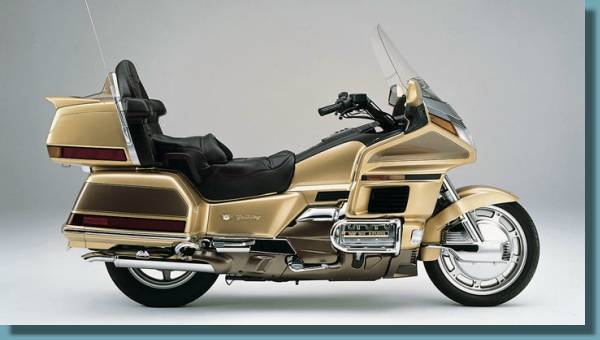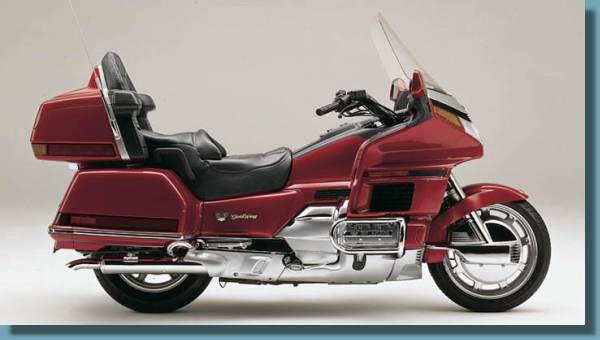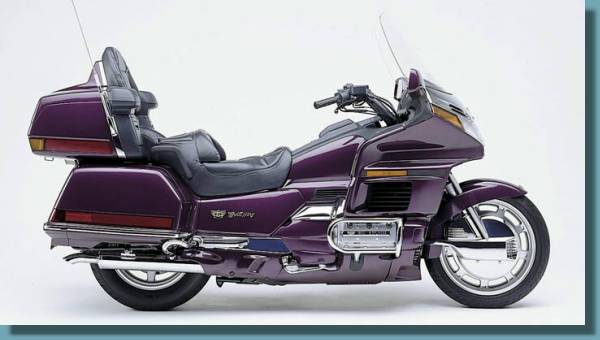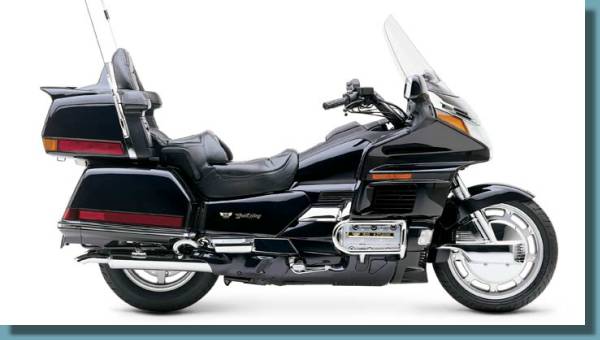After a false start the previous year, the long awaited GL1500 finally hit the buying public for the 1988 model year. This of course was a major new model and totally redesigned from the ground up. The GL1500 now had a silky smooth flat six cylinder engine of 1520cc and a reverse gear, real news for touring motorcycles in those days. This was the first mass produced six-cylinder motorcycle to have a reverse gear and was more in line with the intentions of Honda's 1470cc six -cylinder prototype M1 of 1972. The M1 had been an engineering exercise to see what could be achieved with the available technology of the day and it is possible that the GL1500 engine designers drew some inspiration from the earlier work. All new bodywork on the GL1500 almost enclosed the whole machine and the single key operation of the trunk and panniers, as well as the bodywork design on which not a single screw or bolt could be seen, showed that the Honda designers had spent a lot of time on this bike. They had in fact started work on this machine the same year that the GL1200 was launched! The GL1500 was the quietest Goldwing yet, from the engine to the exhaust note. The traditionalists complained that it looked, sounded and rode too much like a two-wheeled car and indeed riding it gave one a feeling of being insulated from the road. Of course, anyone who traded up to a GL1500 from an older model Goldwing soon adapted to the new machine and I doubt if many GL1500 owners were inclined to offload the new machine for a previous model after riding the six cylinder monster. Monster it was too, in weight as well as size and the first year GL1500 was a colossal 793lbs, although riding the thing was so easy that it felt lighter than the GL1200. The saddle was the most sumptuous yet and was quite capable of carrying the most ample of rear ends for long distances in comfort. Air assisted rear suspension was fitted to the new machine. All of the switchgear, lights, indicators etc. had been designed specifically for the GL1500 and there was none of the all too common "parts bin" approach that was evident on other Honda offerings of the day.
1988 GL1500
Completely redesigned nose to tail, the GL1500 marked a new era for the GoldWing, starting with its silky smooth, powerful new 1520cc flat six cylinder power plant, reverse gear and ultra sleek styling. Colours Blue, Grey, Beige.

1988
1989 GL1500
The 1500 continues to be popular. New colours, Blue Green Metallic, Wineberry Red, Beige.

1989
1990 saw some decent revisions, when the GL1500SE was placed alongside the GL1500. The SE had two-tone paint, trunk spoiler/light, windscreen vent, lighted handlebar switches, adjustable passenger footboards and foot warmer vents that looked better than they worked. All this extra kit on the SE could be yours for about 15% extra cash over the cost of the stock GL1500. Camshaft and carburettor modifications that year helped to eliminate chucking at trundling speed and the trunk and pannier lids were made to fit better in order to keep water out. Rear wheel to drive flange changed from 6 spigots to 5.
Colours, Wineberry Red, Light Metalic Blue, White/Silver/Grey (SE).

1990
1991 saw the arrival of the Interstate, which was now the basic model. The Interstate was 40lbs lighter, due to the lack of reverse gear (no, you couldn't fit one later on folks), cruise control and on-board air suspension compressor, more basic sound system and passenger footpegs instead of boards. Interestingly, Honda lowered the seat height of the Interstate by almost an inch by skimming some of the foam, but didn't do so with the other models. Speaking of other models, the previous GL1500 was now the Aspencade. There was also an Anniversary model (for the 10th anniversary of Goldwing production in the USA), which was available in two-tone gold/brown.
. Colours, Beige (Interstate), Black (Aspencade), Gold/Brown SE.

1991
In 1992, the Interstate got a slightly better specified audio system but no other real news to report then. This and the following couple of years were not exactly a time of inspiration for the Goldwing, although there was some refinement of the model. Perhaps the GL1500 design team can be forgiven for using up all their imagination on the initial model, leaving little in reserve for future improvement.

1992
1993 didn't see much change either, the SE getting the CB radio (previously an expensive Hondaline accessory) as standard. The cruise control now took it's reading directly from the camshaft, which made it more responsive and from now on the 1520cc engines all had needle roller bearings in the rocker arm pivots. Small improvements like this went a long way and tied up the loose ends.

1993
1994 was no different, apart from the usual new colour options and it is testament to the design of the GL1500 that Honda could get away with no major modifications for so long. The GL1500 was so far ahead of the competition in design and specification that it was still selling like hot cakes. Indeed, the Goldwing was Honda's second best-selling motorcycle in the USA in 1994. Nevertheless, the Goldwing community was becoming impatient for change and the presence of Honda folks at major US rallies this last year handing out questionnaires was an indication that something new was at least being thought about.

1994
Finally, the 1995 model year saw some real change. On the surface, new 20th. Anniversary badges, a new chrome screen garnish, slimmer side panels to make it easier for the short legged to get their feet down and some other styling refinements looked like not a lot had changed. But under the surface Honda had managed to make the suspension both lower and stiffer and this improved the handling no end. Also, with some foam shaved from the saddle, the SE and Aspencade were now 40mm lower than before, which finally made them the same height as the Interstate. These changes gave the Goldwing a new lease of life, although there were many who had expected major changes, like better brakes or fuel injection.

1995
The next two years saw no more real changes apart from the Interstate being discontinued in 1996 (not too many folks mourned it's passing either), but by now we were in the early age of the Internet and with many Goldwing web sites and homepages springing up all over the world there was a huge following eagerly seeking out information on a possible replacement for the now rather middle-aged GL1500. A recall to have the bank angle sensor replaced was announced this year and applied to all GL1500 models back to 1988.

1996
1997 saw the SE's lower underbelly panels colour matched to the main panel colour, helping to make the Goldwing look more streamlined. Symbols instead of text on the handlebar switchgear made it easier to read them no matter where you came from. Some important but invisible changes inside the engine were carried out too. The clutch was stronger and some of the components from the Valkyrie engine (main bearings, piston & ring sets, valve springs, con-rod bolts) were now shared with the Goldwing. The Valkyrie final drive was fitted to the Goldwing as well, as was much of the gearbox which gave marginally cleaner and smoother shifting. Not many folks noticed the difference, myself included and I happily rode my new '97 SE for three years oblivious to the differences until I started doing a bit of research on the different model changes.

1997
1998 saw quite a few cosmetic differences, nine in fact. The Aspencade and SE got a new clear plastic headlamp and clear indicators (these were only on the American market models though, Europeans were fobbed off with the old lights and indicators), white faced instruments, new fishtail type exhaust tips that altered the exhaust sound, two-tone saddle with better back support for the pillion passenger, new rocker covers with "1500" gouged into them instead of the previous classy logo strip (which had previously been gold plated on the SE's), a skimpier engine guard (the older one would have hidden the ugly new rocker cover if it had still fitted) and badges that looked more aggressive than before. These cosmetic changes gave the ageing GL1500 a much sleeker look, although such things as the rear lighting setup and flat looking rear-end were beginning to look a bit fussy in the new age of curves and flowing lines.

1998
These changes were carried through to 1999 but by now everyone was awaiting the much anticipated new Goldwing, which had been rumoured for the last three years. Nevertheless, the recent cosmetic changes to the Goldwing were sufficient to keep sales up (no doubt aided this last couple of years by a buoyant world economy), in spite of such mouth-watering hallucinations of a possible 2000cc eight cylinder Goldwing with auto-transmission, or try the one about a V6 2.5 litre replacement with six speed transmission (I know a few rumour-mongers who had red faces a couple of years later). The power of the rumours was very strong and there was always someone who knew someone that had a relative who drank beer with a buddy employed in the Goldwing plant who put the headlamp bulbs in the GL1500 and this guy was sworn to secrecy but... Thus the fever spread and those of use who lived through the time saw it all, the fake photographs doctored so easily by Photoshop gurus and posted on the Internet by members of a now very computer-literate public, the fake postings on web sites and in magazines etc. It was all good fun though and kept us all guessing for a long time. Surely the new model would arrive for the dawn of the new Century?

1999
Disappointment for the 2000 model year and we saw the GL1500 enter another new year alive and well. This was not what was expected for the Goldwings 25th anniversary. The only differences were that Honda had dropped the unpopular white faced instruments (back to black for 2000) and the SE got chromed rocker covers. There was also a nice 25th anniversary badge.
The long awaited new Goldwing was announced in April of that year and the GL1500 finally stepped down after an almost unheard of thirteen year reign at the very top and an increase in weight to almost 820lbs. Most of the other pretenders to the throne didn't fare so well, the Yamaha Venture and Suzuki's Cavalcade had both competed against the GL1200 but the GL1500 had killed them off in short order. The only real threat to the Goldwing in recent times had been the BMW K1200LT, but Honda were about to answer this and set the standard once again with the GL1500's successor.

2000
